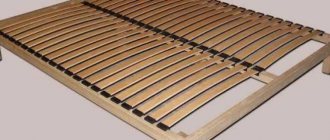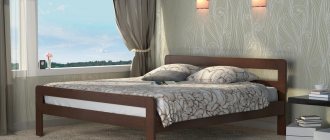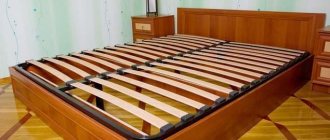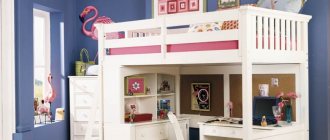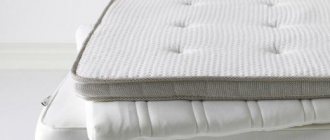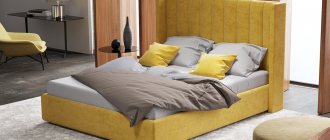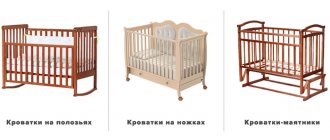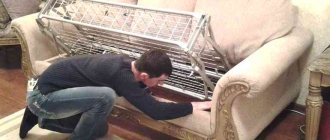The eventful day is over, and you can finally get some sleep. But the insidious bed suddenly begins to make nasty creaking sounds. It seems like a small thing, but it’s unpleasant; the problem needs to be solved somehow. Buying a new bed is not always an option, and it can also creak. So, what to do if your bed squeaks?
Creaking occurs when two parts of a product come into contact; as a rule, this occurs when connections become loose, or due to deformation of the material. Poor assembly results in a completely new bed starting to creak, although this rarely happens. Much more often, creaking does not appear immediately, but over time, when the fasteners weaken during operation, and the wood or chipboard changes in size due to unstable climatic conditions. A spring mattress can also creak when it wears out.
If a wooden bed creaks
The creaking of a wooden bed is primarily due to the characteristics of the material. Wood reacts to changes in air humidity in the room. It becomes damp at high humidity in the absence of heating and dries out in winter when the air is very dry. As a result of such changes, the wooden elements of the bed are often deformed and begin to “walk” relative to each other; even one millimeter of free space between the elements is enough for a creaking to appear. The greater the difference in humidity at different times of the year, the higher the likelihood of squeaks occurring in the near future.
You need to try to find the exact location of the creaking. Start with the mattress, to do this, remove it from the bed onto the floor, crawl on it and listen, if it makes squeaking sounds, then buy a new one. Otherwise, continue searching. Check all fastening connections - this is the most common cause of bed squeaks. Tighten the screws properly. If you cannot fix it securely, secure this joint with a metal angle or bracket. You can try to lubricate the joints of the elements with silicone, paraffin, or, in extreme cases, soap. Lubrication removes friction, which means the squeaking will disappear for a while. If there is a sufficiently large distance between the rubbing parts, lay a piece of felt or felt.
The surest way to eliminate squeaking is considered to be gluing the joints with some kind of elastic glue, such as rubber. It is important to remember to degrease the joints before gluing so that the glue sets well and this work is not in vain. Of course, after such a repair it will no longer be possible to disassemble the bed into parts. But there is a great guarantee of getting rid of nasty sounds.
If you find that the slats are creaking, then proceed as follows. Lubricate the lamella with paraffin or a wax candle. Or pull out the lamella, wrap it with a strip of fabric and insert it back. It happens that it helps to simply swap the slats. It is the lamellas that bear the main load, and over time, cracks may even appear on them. Therefore, if the creaking does not disappear, replace the lamella that has become unusable.
Another radical way to combat the creaking of lamellas is to replace them with two sheets of plywood and carefully screw them to the frame.
The most difficult case is the creaking that occurs from loose bed legs. Repairing old ones or installing new legs is a very difficult process. Often furniture repair specialists offer to cut down the legs of the bed. For the same reason, many furniture factories have stopped producing beds with legs.
How to eliminate the creaking of a wooden bed?
You can also remove the creaking of a wooden bed using the following simple methods:
- Place a pillow or other similar accessory between the wall and the back of the furniture. This method will help minimize the appearance of unpleasant sounds if the problem is a movable headboard. With the help of a pillow it is fixed in a stable position.
- Secure the bed on both sides using any furniture set. You can give preference to ottomans, cabinets, chests of drawers. This method very often helps to correct the situation with loose furniture.
If both options fail to solve the problem, diagnostics will be required to determine the location of the squeak. An unpleasant sound should be eliminated in the part of the sleeping area where it appeared. There is no other way to correct the situation.
It is necessary to localize the source of the bed noise.
Eliminating the creaking of a metal bed
Metal squeaks are especially unpleasant. Tighten the fasteners, lubricate the joints of the parts. Some models have front and side walls connected by Click-Clack mechanisms, which quickly become loose and begin to creak. It is better to replace them with ordinary bolts and nuts.
If you find touching surfaces on a metal base that make a creaking sound, cover them with tape.
When a worn armored mesh creaks, it is easier to replace it with any other base. You can treat the springs with WD-40, but this is painstaking work, the results of which will not last as long as you would like.
If the reason is in the assembly
What to do if a metal bed creaks due to incorrect assembly initially? One of the structural elements may be out of place, which leads to unpleasant sounds.
There is only one way to correct this defect - dismantling and subsequent reassembly, which will comply with the instructions. Often, errors are made during factory assembly, so the product has to be returned to the store where it was purchased. Such cases are rare, but they are possible.
You can fix the problem yourself or seek the help of specialists. In any of these cases, the solution is quite simple and does not require a lot of time and money. A refurbished bed will serve you for quite a long time.
Air bed creaking
Unfortunately, many air beds squeak a lot. Sound is generated by the contact of rubber surfaces. And it is unlikely that we will be able to completely get rid of this phenomenon, but we can weaken it. To do this, place the air bed on the carpet, cover the mattress with a woolen blanket, and then cover it with a sheet.
Basically, beds begin to make an unpleasant squeaking sound when friction occurs between 2 surfaces.
A squeaking sound in a bed occurs when friction occurs between two surfaces.
At first glance, it may seem that removing the squeak is easy; there is nothing to rub in the bed.
In reality, almost anything can creak. Most often, beds are made of chipboard or wood. The parts are fastened with special fasteners, or self-tapping screws are used for this purpose. The design of such fasteners does not exclude slight movement of parts relative to each other. In addition, materials tend to deform and change in size over time. In this regard, it is very difficult to combine the parts so that there is no relative displacement and it is possible to get rid of the creaking of the bed.
Often the problem occurs in the place where the leg is attached to the side. In this case, the main fastening elements are a bolt and a nut, but you should not overtighten the connection; you may damage the leg or sidewall. And if the tightening is weak, due to the elasticity of the wood, slippage occurs, causing creaking. Moreover, in such a situation, a constant weakening of the connection occurs. There is no point in tightening the nut; in this case, the recess will be pressed down even more. This applies equally to both wood and chipboard.
Determining the source of the squeak on the bed
Of course, it will be better to work in pairs, since it will be inconvenient for one person to “wobble” the bed and listen to sounds. To calculate the seats, you need to lie on the bed and turn over, simulating a standard night's rest. At this time, your partner should listen to where the creaking is coming from.
It often happens that the source is in the joint of the corner frame or in the places where the legs come into contact with the base of the bed - how to get rid of a squeaking bed.
- To fix the squeaking of the bed, we will need open-end or adjustable wrenches if the connection is bolted, or a screwdriver if there is a screw connection. Try to tighten all the connections, but not too much, so as not to crush the wood. If the bed continues to squeak, then you should look for other sources.
- It happens that the mattress rubs against the bed - try to level it so that it does not come into contact with the walls of the frame. If the problem is not corrected, you need to move on to an orthopedic foundation. Remove the mattress from the bed to the floor and check it at the same time; sometimes the springs creak.
- Lie down on the slatted base and fidget a little; the slats can creak from the pressure on them as your body moves. The bed creaks, what should you do? You can fix the creaking with WD-40. To do this, you need to carefully spray all the connecting places of the bed before tightening the bolts and nuts.
Main options
It should be noted right away that when buying a standard bed, the question always arises of how to get rid of squeaking. But making a bed yourself is not suitable for everyone, so you can still take certain steps to eliminate unpleasant sounds. First of all, you need to glue the joints and joints. For this purpose, you can use rubber glue. According to experts, in such a situation, rubber glue has undeniable advantages. It should be taken into account that any creaking area is characterized by the presence of a strong load and some deformations. Basically, all adhesives form strong seams, but they are still not resistant to deformation.
As for rubber glue, its use produces an elastic seam, which is ideal for this task. First of all, when using rubber glue, a rubber film is formed on the surface to be glued. Even if there is an air bubble and the surfaces mutually shift, there will be no squeaking. Indeed, in this case, surfaces coated with a rubber film will come into contact with each other.
Return to contents
Quick methods to get rid of squeaks
- Cover the frame support bars with plenty of clothing. Choose something you haven't worn for a long time. The fabric will prevent the orthopedic base or mattress from coming into contact with the bed frame and creaking.
- Use a cork seal, this will help get rid of unnecessary joints in a bed with a wood frame. Inspect your bed for any joints where the orthopedic base or mattress could potentially “roll” and come into contact with the bed frame. You will need to glue cork sealant at these joints so that all the furniture pieces fit together neatly.
- Place a book under the mattress (near the source of the squeaking noise). If the source is located near the support bars, remove the mattress. Later, place the book on the creaking bar. After that you will need to return everything as it was.
- If the cabinet doors squeak, install new hinges for the doors. Install new hinges (choose long screws). There will be no trace left of the squeak.
Squeak elimination technique
To eliminate the squeak, you will have to disassemble the bed. The first stage of work is to degrease the joints of the parts. After this, each bonded surface is treated with a thin layer of glue. After this, let the surface dry slightly. After this, the glue-coated surfaces need to be aligned and pulled together in the same way as was done before. Now you need to leave the bed and not use it until you are sure that the glue has dried.
Check the quality of the screws that connect the wooden furniture elements. If necessary, all connections can be strengthened from the inside using steel angles. To process wooden parts at the joints, you can use not only rubber glue, but also graphite lubricant, or use a special spray based on silicone.
In addition, to determine the cause of the squeak, inspect the boards on which the mattress is located. They often sway and become deformed, causing unpleasant sounds. In this case, they can be turned over, and if the desired results are not achieved, then replaced. And finally, it is not the wooden parts of the bed that can make a squeak, but the springs of the mattress. In this case, there is nothing you can do to fix it and you will have to buy a new mattress.
Over time, any wooden furniture begins to emit various sounds, which the owners fight with all available and known methods. It’s especially annoying when the bed you have to sleep on every night starts making sounds. A creaking bed can deprive you of healthy sleep, ruin the quality of sex with your loved one, and with its loud sounds, disturb the sleep of household members even in the next room. How to rid yourself of this minor but unpleasant problem? The very first step is to find out what is causing the bed to squeak.
Eliminating squeaks
When a wooden bed creaks, it can cause many inconveniences. During sleep or rest, unpleasant sounds and friction irritate and worsen your mood. It’s unlikely that anyone will like squeaky beds. Determining the exact source of the sound will help you choose a method to eliminate the problem, making sleep and relaxation pleasant and comfortable.
The following are some simple ways to stop a wooden bed from squeaking:
- You need to take a pillow or other thing and place it in the space between the headboard and the wall. The creaking due to the movable headboard will stop, since it will be fixed in one position;
- The second option is to press the bed on both sides with other furniture. For example, a chest of drawers, a nightstand, an ottoman. In this case, the loosened bed will stand firmly and not wobble.
If the simplest methods for eliminating squeaking do not work, you need to approach solving the problem more specifically. You need to get rid of squeaks depending on the parts of the bed. The mattress, headboard, frame and base can creak.
Press the bed on both sides Place pillows behind the headboard
mattress
Sometimes the mattress just lies unevenly on the bed, try to place it correctly. The reason also depends on the type of mattress. Their filling can be polymer or spring. Inexpensive models make squeaking noises due to the contact of springs. Only replacing the mattress will help get rid of the problem.
Expensive models are designed in such a way that each spring is located separately in a case, which performs a protective moisture-repellent function and prevents friction of the springs. If an expensive mattress squeaks, it is recommended to turn it over. The load on worn areas will be less, and the creaking will stop for a while.
Mattresses with polymer filling also make unpleasant sounds. They may be associated with a violation of the tightness of individual chambers. Air flows from one chamber to another and produces a characteristic sound. If the polymer mattress begins to creak, it must be replaced.
Adjust the mattress Turn the mattress over
Headboards
The headboard can also cause a wooden bed to squeak. The most common is loosening of the drawer. The creaking appears in the places where they connect to the headboard. It is recommended to tighten all bolts and all connecting elements.
If simply tightening does not help, you will need felt, felt or rubber pads. For greater reliability they are glued. In this case, it is necessary to take into account the fact that it will become more difficult to disassemble the bed.
Check the frame Change the gaskets
Frame
A wooden bed usually creaks after several years of use. This is due to the fact that there is dry air in the house or apartment. It causes the tree to dry out. Individual elements dry out and small gaps appear between them. Thus, the parts begin to move and touch. They wear out and the gaps increase. The creaking gets louder.
Causes of squeaking
A wooden bed may begin to creak due to the natural drying of the material or the simple loosening of fasteners. To find out the real reason, you first need to remove the mattress, throw it on the floor and check for squeakiness. Perhaps the bed has nothing to do with the sound. If you find out for sure that the bed is creaking, you will have to crawl thoroughly on it to determine the exact source of the emanating sounds. These could be old legs, boards under the mattress, places where elements meet. After the creaking place is found, we will try to get rid of the squeaks.
It's not the bed that's creaking, it's the springs.
How to determine the source of a squeak
First of all, you need to determine why the bed creaks. Since bedroom furniture consists of many parts, each will have to be considered separately:
- First, the bedding is removed from the bed and the mattress is pulled out. It is checked by tapping, or alternatively, it is subjected to loads. The mattress should be laid on the floor, if the size allows it, it is permissible to jump on it to try to cause an annoying sound. Both spring products and models without metal weaves can creak. In the first case, the metal may burst or rust; in the second, a low-quality polymer that does not withstand loads is usually to blame.
- The next slats in line are the slats on which the mattress is placed. There are at least 30 of them in the average bed. Since they are made of wood, it is possible that individual elements have burst or cracked. Each of the lamellas must be carefully inspected.
- Next, the condition of the frame is assessed. The supporting structure, which consists of the headboard, sides and back, can also dry out. This leads to the appearance of gaps and cracks, which, in turn, provokes annoying squeaking.
- To check the reliability of fastening connections, do not loosen the frame, as this can further damage the furniture. It is better to inspect all fastening points, paying special attention to the fit of the elements and the reliability of their fixation.
- The last thing to study is the lifting mechanism. Although not all beds are equipped with it, it is in such models that the problem may well lie in the lift. Rusty or skewed elements indicate creaking from this particular mechanism.
Popular models of soft beds, options for designing headboards
If the check does not yield results, and the problem is still not found, you need to inspect the floor on which the bed stands. Loose floorboards under load can be a source of unpleasant sounds.
The creaking of the bed can also be caused by the head of the furniture rubbing against the wall.
Remove the mattress and check it for squeaks
Inspect each lamella, assess the condition of the frame
Check the fastening connections without loosening them
Inspect the lifting mechanism
How to eliminate squeaking
The easiest way is to tighten better all the screws, screws and nuts with which your bed is assembled. In more serious cases, you can additionally secure the joints with metal corners on the inside, and coat all joints with wood glue. You should not use the bed until the glue has completely dried.
If there is nothing to tighten, you can try to lubricate all the joints of the elements with some lubricant. This could be silicone grease, soap, baby powder, candle paraffin, grease. Extreme care must be taken when lubricating to avoid damaging the appearance of the wood furniture. After lubrication, friction disappears, therefore, the squeak disappears.
Another way to solve the problem when the bed creaks is to replace or rearrange the slats that support it. They bear the main load and often quickly become unusable.
Eliminating a squeak is quite easy, the main thing is to find its source
In some cases, the only possible way to get rid of annoying sounds is to simply saw off the legs of the bed. This method is especially relevant if the furniture is not made from solid pieces of wood, but from chipboards that cannot be repaired. Then the bed turns into a stylish floor bed, which, however, is not suitable for every owner.
Wooden furniture is distinguished by high quality production, long service life and luxurious appearance. However, even such household items fail over time for various reasons and begin to present unpleasant surprises to their owners. Considering this, many are interested in what to do about it if a wooden bed creaks and how to fix the problem.
Similar articles:
How to eliminate a squeak
What to do if the orthopedic metal bed base creaks? Check the fasteners carefully. The bolts and nuts are thoroughly tightened, simultaneously lubricating them with Vaseline or special compounds. The wooden base is not tightened, but you can lubricate them with wax or Vaseline once again.
Carefully treat the joints of the front and rear backrests with the sides of the bed, the points of contact between the frame and slats. Wooden parts are lubricated with wax, soap, silicone or petroleum jelly, metal parts with silicon or lithium grease. If this does not help, gaskets are inserted between the parts to eliminate friction.
When the lamellas squeak, you should first try to lubricate them with wax or paraffin. The second option is to swap them or pull them out of the groove, wrap them in cloth and insert them back. If all else fails, the rack is cracked under stress and will have to be replaced.
Securely fixing them will help get rid of squeaks in furniture legs. If this does not help, you will have to replace the parts with new ones. The same goes for the lifting mechanism. It is thoroughly lubricated and tightened, or, as a last resort, replaced with a new one.
Causes of squeaking at the bed
If your bed creaks, you shouldn’t despair. This problem can be easily fixed. Even a person far from construction can cope with this process. The main thing is to immediately determine the location of the squeak and understand what its cause is.
In order for the search to be successful, it is necessary to free the bed from all objects, including the mattress, and use force to shake and push all the parts (legs, back and foot, base, etc.). A superficial inspection will tell you where the sound is coming from. Then all that remains is to more carefully examine the squeaky area and understand the exact location of the friction. Most likely:
- connecting parts of the base at the corners;
- places where the legs connect to the frame;
- any of the connections of the slatted or slatted base;
- places where the legs touch the floor.
The reasons why a wooden bed creaks almost always come down to one thing - the material has dried out, cracks have formed at the joints, and adjacent parts begin to rub against each other. The problem becomes especially pronounced if wet raw materials were used during production. As a result, even the purchased bed can creak.
Another common cause of an unpleasant sound can be wear or loosening of the fasteners.
If, after examining the piece of furniture, the creaking does not manifest itself in any way, then the cause must be looked for in the mattress or in the places where it comes into contact with the wooden base.
Once the location of the squeak has been detected, you need to determine a method for eliminating the problem and understand what to do if a wooden bed creaks.
Determining the causes of the squeak
Most common problems
As you can see in the photo, wooden furniture looks very beautiful.
Most people prefer to buy wooden furniture out of habit and aesthetic preferences, since no material can compare with wood in the beauty of its design. However, it should be understood that this material has special properties, including a tendency to deformation and changes in geometry. They lead to undesirable effects, such as creaking.
Important! The strength of wood is relatively low, and the places of fastenings, joints and connections become loose and loose over time, which causes play, which results in friction, leading to creaks.
Wood has a number of features that lead to the appearance of noise during deformation.
So, we have shown that the occurrence of noise is almost inevitable due to the properties of wood, and most often they arise for the following reasons:
- Wooden parts dry out or absorb moisture, and their geometry changes. Uneven changes in the dimensions of fasteners, changes in gaps and cracks lead to friction and backlash, which cause unpleasant sounds; (See also the article Sealing cracks in a wooden floor: features.)
- The places where boards are fastened with bolts, tenons, nails or self-tapping screws gradually wear out under the influence of loads, the holes become larger, the fastening tenons or dowels are deformed, the screws are unscrewed and the nails become loose. All this leads to displacement of parts relative to each other with inevitable friction and creaking;
- The geometry of the frame itself changes, the legs give way, the angles change. The structure becomes less stable, loads begin to act in other directions and again lead to noise and creaks.
In addition, the mattress can creak, especially if it is spring. Also, a metal mesh can be installed on a wooden frame to support the mattress, which also sometimes begins to make sounds.
What to do if a wooden bed creaks? First, find out the reasons.
Finally, the floorboards located under the legs of the bed can creak. Also, the back or side board of the product may rub against nearby furniture or a wall.
Determining the problem area
You can understand what to do to prevent a wooden bed from creaking by finding the problem area.
Now you need to find the source of the sound. This is important, since accurately determining the location will make it easier to eliminate noise.
It is necessary to shake the structure along the longitudinal and transverse axis, while listening carefully. If noise occurs, then the problem is in the frame or the leg mounts.
Shake the structure to check the connections of the frame and legs.
If the swaying does not produce any special sounds, then you should lie down on the bed and turn around on it. If this results in squeaks, then the problem may be in the mattress, support slats or frame, or in the joints of the wooden bed. Try to understand where exactly the noise is coming from.
You can also remove the mattress and turn it 180˚. In addition, you should move the mattress and lay it as evenly as possible in the center, and if it was still lying there, then, on the contrary, move it slightly: changing the distribution of loads can eliminate the cause of the sound.
Remove the mattress, check the support, turn the mattress over.
Important! Try moving the bed a little. Perhaps the floorboards are creaking or the back is rubbing against nearby furniture.
Determining the source of the squeak
To quickly find the source of unpleasant sounds, you need to ask someone close to you for help.
First you need to simulate a night's sleep: lie on the bed, turn in different directions, and at this time the assistant will listen to the place of origin of the sounds.
If a wooden bed creaks when a person moves in a lying position, then the source may be the joints of the legs and the base of the frame, as well as the corner joints of the lounger. Problems can also arise in wooden planks. Even unused slats that are not screwed securely will begin to creak from the first day.
An uneven floor causes the legs to constantly shift, producing an unpleasant grinding noise. Old floorboards may creak, and the sound may seem to be coming from the bed.
If, after a long search, we couldn’t find anything on the furniture itself, we move on to the mattress. Since he’s just lying on the floor at this time, let’s lie down and try to detect extraneous sounds inside him. This means the problem is in the springs.
The final source of squeaking is where the mattress meets the base of the bed. To detect it, you need to return the mattress to its place and carefully roll on it. The source of the noise cannot be detected immediately, but only after the mattress is installed in the position that is problematic.
After all search methods have been implemented, you need to proceed to the last stage - eliminating the creaking of a wooden bed.
Determining the source of squeaks
Before fixing the problem, you need to find out exactly which elements are damaged. To find out the cause of the squeaks, you need to remove the mattress and check every detail:
- press on the anatomical base
- test lifting mechanisms
- check the correct fixation of the lamellas
- shake your legs
- make sure the fasteners are secure
- carefully inspect all joints of parts
Most often, the anatomical base creaks. Drying of wooden slats leads to a change in their size, which causes friction with the frame. The appearance of a grinding noise can also be caused by loosening of the fasteners that hold the planks or by their displacement.
Remove squeaks without disassembling the bed
The easiest way to eliminate the creaking of a wooden bed is to create a soft pad or strong support. You need to insert a soft object into the space between the headboard and the wall. Sometimes this helps soften the contact between two hard materials. On the free side, you need to support the foot with a chest of drawers or a heavy stand. This will help fix the furniture in the desired position and prevent its movement.
Such actions do not always help and do not last long. Therefore, to prevent the bed from creaking, you will have to use tools.
First, the fastening elements are tightly tightened using open-end or adjustable wrenches or screwdrivers. Most often, access to them is carried out without disassembling the furniture, but sometimes additional fastening in the form of metal corners and gluing joints may be necessary.
Do not neglect the intermediate method of coating in the connection of the frame, legs, headboard and foot. Even if it is not needed now, such processing will not be unnecessary.
It is necessary to consider how to get rid of bed squeaks if the cause is worn slats. First you need to swap the central and outer elements to relieve the stress on the tired wood. If this does not help, you will have to change the lamella.
Debugg
Most often, an unpleasant grinding noise indicates defects in the structure itself that require repair. But before resorting to serious measures, it is worth trying to cope with the problem using easy methods. How to remove a squeak in the simplest ways:
- Insert a pillow or similar object into the space between the bed and the wall. This will prevent annoying sounds and also minimize frame vibration.
- Press the bed with other furniture; cabinets and chests of drawers are best suited for this. Once fixed, the product will not wobble, and accordingly, the issue of rattling will be resolved.
If such tricks do not help, and the bed creaks again, you should determine the exact cause, and then get rid of it using the recommended means. A variety of tools may be required for these purposes, depending on which part of the bed needs repair. It’s definitely worth stocking up on a wrench of the required diameter and a suitable screwdriver. In addition, a silicone-based lubricant will be useful for lubricating the fasteners.
Place a pillow between the headboard and the wall or press the bed with a nightstand
Frame
Problems with the frame are typical of wooden beds, since the material dries out due to dry air. Small gaps appear between parts that have lost their grip, causing them to touch during movement, producing a grinding noise. If measures are not taken, the elements will wear out even more over time, and extraneous sounds will intensify.
To prevent the bed from creaking, stand in sequence:
- Tighten the fasteners - it is important to go through all the joints, tightening the bolts and tightening the screws. Do not use excessive force, as this may lead to deformation of the wooden elements. If, after tightening, the fastener is still loose, it is equipped with a washer, which will make the joint tighter.
- Apply lubricant - there are special anti-friction compounds in the form of aerosols, gels, sprays, the most famous is WD-40. To avoid purchasing a store-bought product, you can rub the parts with a paraffin candle or soap, but this must be done regularly.
- Install gaskets - they are required for large gaps, which are covered with rubber or felt elements. They are glued in places of gaps, tightening the fasteners so that they fit tightly to the gasket.
Advantages of forged beds, features of combination with the interior
To prevent the bed from creaking, you can strengthen the frame. First you need to disassemble it. Dust and dirt are removed from the elements, and the joints are degreased with alcohol. Next, PVA glue is applied to them (it is better to use wood glue), after which the parts are quickly connected and tightened.
The bed cannot be used until the glue has completely dried; in general, this takes 2–3 hours.
Tighten fasteners
Apply lubricant
Install gaskets
Lamels
The orthopedic base of the bed consists of lamellas, which are wooden slats mounted in the space of the frame. They take on the main loads, so they wear out quite quickly. To repair the base you will need:
- Replace the slats if cracks or chips appear on the old parts.
- Replace the lat holders if the places where the lamellas are fixed are broken.
- Tighten the fastenings of the slats themselves.
- Lubricate the ends of each part that squeaks. It is revealed by pressing the lamellas one by one. A silicone compound is best suited for lubrication.
- Close strong gaps with felt or polystyrene foam.
In cheap models of beds without lath holders, experts advise placing soft fabric under the screws of the slats.
Replace the slats if they are damaged
If the lat holders are broken, replace them
Tighten the slat fastenings
Lubricate the ends of parts that squeak
Mattress
If the mattress creaks, it is quite possible that it simply lies incorrectly, loading individual areas of the base too much. To stop the bed making unpleasant sounds, the product should be turned over to the other side.
If the reason lies in low-quality or outdated springs, the mattress will have to be completely replaced. Alternatively, you can try to send it in for repairs. The craftsmen will go through all the springs, replace the damaged ones and install them correctly. In terms of cost, such work will be slightly cheaper than purchasing a new product.
In expensive mattresses, each spring block is placed in a separate cover, which not only counteracts friction, but also protects the metal from moisture. It is enough to simply turn such models over so that the worn parts are subjected to less stress and the creaking stops.
Polymer mattresses that do not have springs can also make extraneous sounds. Most often this is due to leaks in the chambers and air getting into them, as a result of which even a new bed creaks. Unfortunately, such a product will have to be replaced.
Turn the mattress over and replace if there is internal damage.
Headboard
Typically, the headboard is a massive piece attached to the drawers (side walls of the frame). If they wobble, the wooden structure will creak, so first of all you should tighten the fastening elements at the points of their connection. If there is no effect after tightening, felt or rubber pads should be used. They are applied to the joints, secured with glue. You can even apply a gasket to the entry point of a bolt or self-tapping screw, punching through a pad that will go around the fastener, reducing its friction.
Review of the most original beds in the world for adults and children
Tighten fastenings
Lifting mechanism
Beds with a mechanical or electric lift system are also susceptible to squeaking problems, which may be due to wear and tear on the lift itself. In this case, it is recommended to lubricate the squeaking mechanism, as well as tighten the bolts and nuts. You need to be careful, because excessive tightening can lead to breakdown of the entire system. If the manipulations done do not produce results, all that remains is to replace the lift. Here you will have to turn to specialists who will select a similar mechanism and repair the bed.
Lubricate the lifting mechanism
Dismantling the bed
The most radical method of eliminating the creaking of a sleeping bed is to completely disassemble it and process each part separately. To do this you will need the following tool:
- wrenches and screws;
- Screwdriver Set;
- screwdriver or drill;
- brushes, rollers, sandpaper;
Important: you need to immediately prepare the necessary fastening consumables, metal corners, rubber glue and lubricants (wax, paraffin, soap, ski or graphite grease, etc.).
To easily unscrew the fasteners, you must first understand which of them are used:
- Planks with hooks or a special bed screed can be disassembled by simply detaching the parts from each other.
- The screw coupler is intended for end connection. Consists of a screw and a nut. Unscrews with a hex key.
- The canonical tie is unscrewed with a Phillips screwdriver.
- Euroscrew fastening is a metal screw screwed into a pre-prepared hole. Removable with a hex wrench.
- Connections using dowels or wooden cartridges coated with glue are more difficult to remove. To do this, you need to gradually insert a thin object (a screwdriver or the end part of a knife blade) into the gap between the fastened parts and move them apart until the entire dowel appears outside. Then its free part is grabbed with pliers and pulled out.
Disassembling the bed begins with removing the foot and headboard. Then you need to disconnect the base from the frame. If necessary, disassemble the components themselves, detach the slats, legs, etc.
As you disassemble, carefully inspect all fasteners on the bed. If a damaged thread is found, replace the screw or bolt with another one. It is recommended to replace the removed dowel.
To create a strong, unified structure, before assembly, all parts and joints are treated with rubber glue. Before gluing, it is recommended to degrease the wood surface.
What do you do with old furniture?
| Causes of bed squeaking. What can be done to get rid of the nasty sound? What to do? How to eliminate a squeak? (10+) Why does the bed squeak? What to do? |
Causes of bed squeaking
The cause of squeaking is usually friction between two surfaces. Creaking occurs when one part rubs against another. It would seem, why rub in bed? But in fact, literally everything in the bed creaks. Most beds are made from wood or chipboard. The parts are fastened with self-tapping screws or special fasteners. This fastening does not prevent slight movement of one part relative to another. Since both wood and chipboard tend to deform and change their dimensions over time, it seems very difficult to securely press one part to the other so that there is no relative displacement, and therefore creaking.
Pay attention to the diagram. This is the attachment of the bed leg to the side - top view. A nut and bolt hold the leg to the side. But you cannot tighten such a connection too much, as otherwise you can break the sidewall or leg. And if the tightening is not very strong, due to the elasticity of the wood, slipping will occur and creaking will occur. The connection will also gradually weaken. Tightening the nut is useless, as it will simply push the recess into the wood or chipboard even deeper.
The main causes of bed squeaking
What causes bed squeaking? Most often, creaking is a consequence of friction of wooden or metal elements, resulting from partial wear of the parts and components of the bed.
A quality bed is the key to a sound sleep!
Techniques for eliminating squeaks can be divided into three groups:
- strengthening of the structure due to additional fastenings;
- sealing joints with porous elastic materials;
- reduction of friction through the use of anti-friction lubricants.
Creaking can occur in various structural elements of the bed. Most often, creaking occurs in the following nodes:
- joints and places of fastening of bed frame elements made of natural wood or chipboard;
- bed base or frame with wooden slats;
- lifting mechanism;
- spring or polypropylene mattress.
Why might the bed squeak?
Methods for eliminating unpleasant sound vary for different bed components. An incorrectly chosen repair technology will not only be useless, but will also lead to further abrasion of materials and increased sound.
Video - Why does the bed squeak?
Prices for double beds
Eliminating the creaking of a wooden bed
What to do? How to proceed? How to eliminate squeaking? It is almost never possible to completely eliminate bed squeaks and get rid of the nasty sound in standard commercial beds. To prevent the bed from squeaking, you need to do it yourself, then you will be guaranteed against squeaking. How to make a bed without squeaking yourself, with your own hands.
But still, something can be done. The joints, similar to those shown in the figure, and the joints of the walls need to be glued. I do this with rubber glue 88 (Luxe). The advantages of rubber glue in this situation are undeniable. Firstly, the places where the bed creaks are characterized by heavy loads and some deformations. Most adhesives form a strong seam, but it is susceptible to deformation, since the seam is not elastic. Rubber glue gives an excellent elastic seam. Secondly, rubber adhesive forms a rubber film on the bonded surfaces. Even if there is an air bubble there and mutual displacement of the surfaces is observed, then there will be no creaking, since the surfaces covered with a rubber film will rub against each other.
To eliminate the squeak, the bed must be disassembled. Degrease the joints of parts. Next, apply a thin layer of glue to each surface to be glued. Let it dry a little. Then the surfaces, each of which is covered with a drying film of glue, are combined and tightened in the same way as they were previously secured. Read here how to re-screw a self-tapping screw correctly. Leave the bed alone until the glue has completely dried. It is better to dry for 24 hours, during which time maximum strength will be achieved. If you rush, you can ruin everything.
Attention!
A bed taped in this way will be very difficult to disassemble.
Residents of Shymkent were deprived of peace by “moans and creaks of beds” in rented apartments May 5, 2020, 05:18
The surge in demand for rental apartments during quarantine has deprived residents of the residential areas of Shymkent of peace. Now they are forced to observe someone else’s stormy self-isolation both day and night. Moans, screams, fights, noisy groups - people do not know how to get rid of such a neighborhood, reports Channel One Eurasia.
In the high-rise buildings on Aibergenov and Zhangeldin streets you can rent an apartment at any time. People retire in pairs or as a whole crowd. They may celebrate something, usually with alcohol. And call girls are optional.
“So what, quarantine. Daily apartments are rented out and the business is running. It is we who are forbidden to leave our houses. Schools and kindergartens are closed. It doesn't concern them. People constantly come to the neighboring apartments. They film for several hours, for a day. They break everything, there are cigarette butts, bottles, condoms all around. And the girls they bring here for pleasure are sometimes so drunk that they can’t stand on their feet. And our children see this,” the resident of the house is indignant.
Nobody remembers the neighbors here. They change every day. There are only a few permanent residents. They have to be unwitting witnesses of romantic evenings through thin walls. Dancing, fights, reconciliations - all this happened before. But now the degree of passion is just off the charts.
“We live in constant “concerts,” both day and night. There is noise and fun in these apartments, and then some kind of showdown begins. At night there are screams, moans, the creaking of the bed, we don’t even know what to answer to our children. Shame and disgrace. Decent people don’t come here,” complains another resident of the ill-fated house.
“Our building has five entrances and 100 apartments. Of these, only 10 are permanent residents, the rest are daily residents. We turned everywhere - both to the akimat and to the police. Nothing changes,” says another.
“I turned to the officials: “Help!” Useless. I wrote to the prosecutor’s office and the district police officer. I went everywhere. No measures were taken. Maybe it will subside for a while, then again. This is a nightmare,” said house resident Svetlana Naydenova.
The police are also scratching their heads: renting out an apartment is not a criminal offense. You can only be fined if you are caught in the act.
“During the raid, we identified about 300 apartments for rent and submitted an application to the tax office to determine the legality of their activities. Women offering apartments were identified. 13 administrative protocols have been drawn up,” commented the head of the department of the local police service of the city, Danabay Aliyev.
